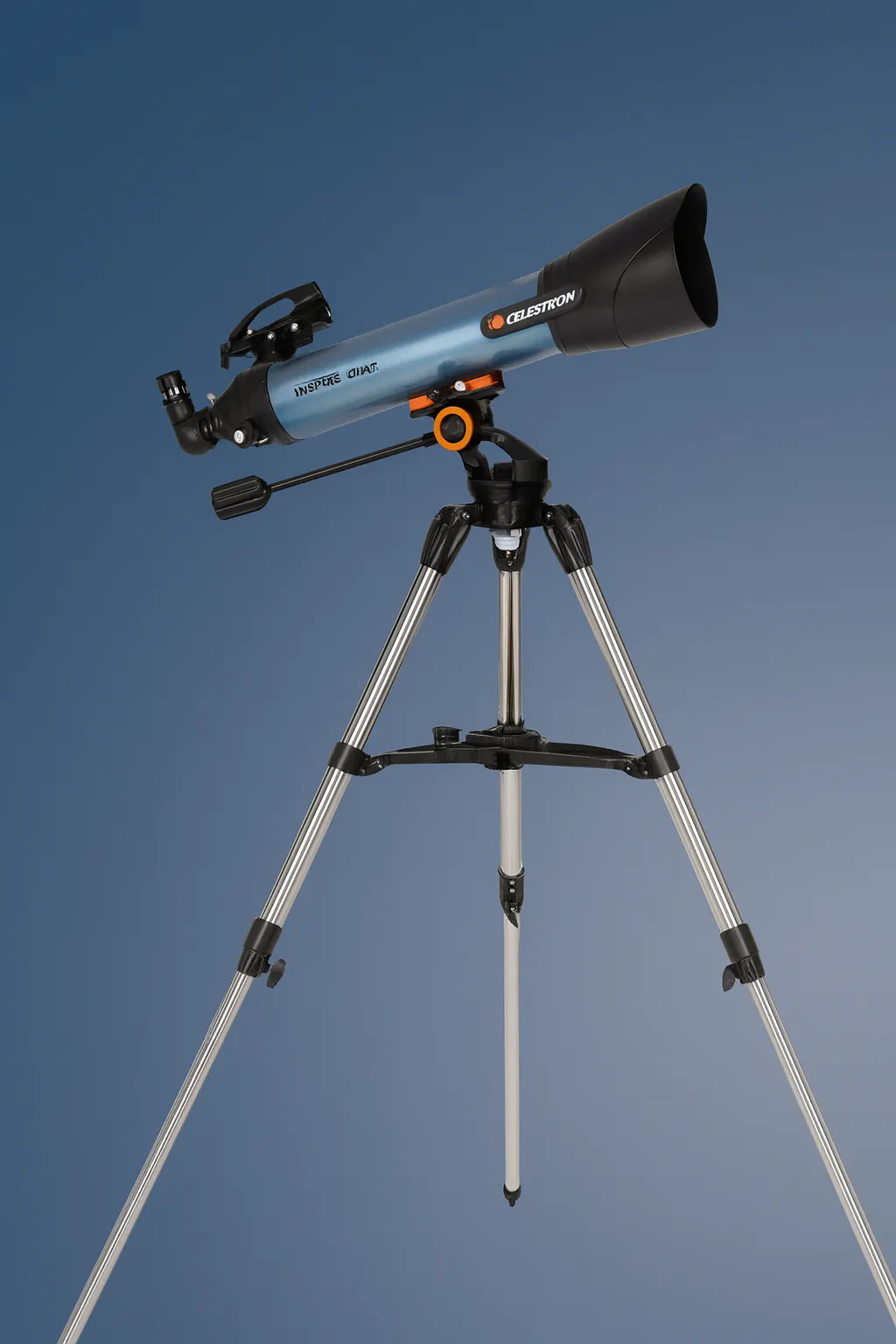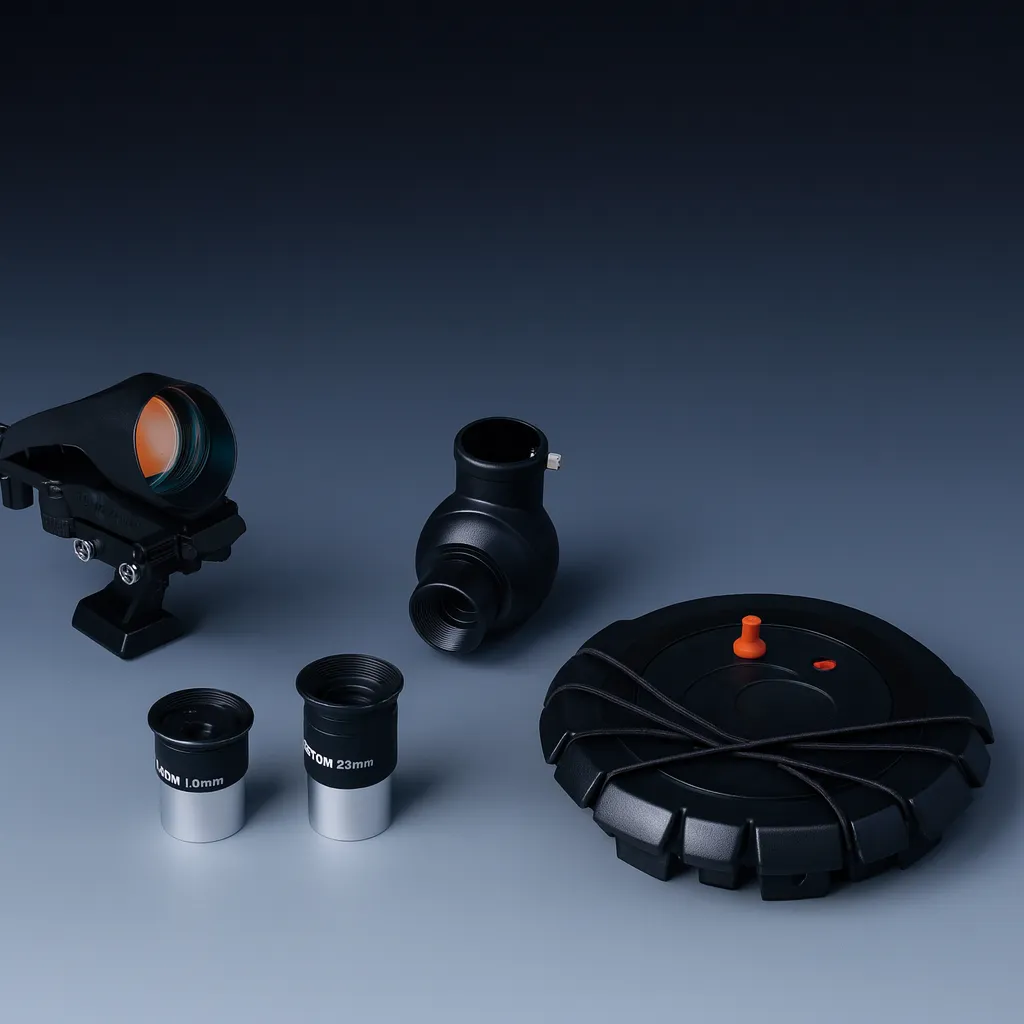Introduction
The Celestron Inspire 100AZ is marketed as an easy-to-use refractor for beginners, with smart accessories and decent optics for its price. While the telescope delivers good planetary views and helpful extras, its plastic focuser remains a recurring criticism among reviewers, making it less appealing compared to sturdier alternatives.
Pros
- 100mm aperture provides solid beginner-level optics
- Sturdy steel tripod compared to most in this price range
- Innovative accessories: lens cap smartphone adapter, red flashlight
- Good lunar and planetary detail for beginners
Cons
- Plastic focuser is wobbly and imprecise
- Chromatic aberration visible on bright targets
- Mount is mostly plastic and not very stable
- Eyepieces and diagonal are basic quality
Choose a vendor
- Buy on Amazon
Recommended for lower priced general purchases.
- Buy on HighpointScientific
Recommended for all purchases.
- Buy on AstroShop
Recommended for European buyers.
Optics
The Inspire 100AZ’s 100mm (4”) aperture provides enough light-gathering ability for lunar and planetary targets. Jupiter’s cloud belts and moons, Saturn’s rings, and craters on the Moon are all within reach. However, deep-sky performance is limited—bright star clusters like the Pleiades are visible, but faint nebulae and galaxies remain out of reach compared to larger reflectors. The fast f/6.6 focal ratio also introduces noticeable chromatic aberration on bright objects, though this is typical for achromatic refractors in this price range.

Mount & Tripod
The Inspire’s alt-azimuth mount is serviceable for casual observing but is mostly plastic and prone to vibrations. The inclusion of a panning handle helps with smooth movement and locking. The tripod, on the other hand, is made of stainless steel and is sturdier than many beginner scopes in the same category. Still, overall stability lags behind Dobsonian bases or higher-end refractor mounts.

Accessories
Celestron includes a range of accessories with the Inspire 100AZ. Two Kellner eyepieces (10mm and 20mm) provide 66x and 33x magnifications, respectively. The 20mm eyepiece is better suited to the telescope’s capabilities, while the 10mm feels dim and narrow. A red-dot finder aids in targeting, and a basic diagonal provides corrected terrestrial views at the expense of some image quality. Notably, the lens cap doubles as a smartphone adapter for simple astrophotography, and the accessory tray integrates a small red flashlight—a thoughtful touch for nighttime use.
Focuser
The weakest component of the Inspire 100AZ is its focuser. Made mostly of plastic, it tends to wobble, especially at higher magnifications, making precise focusing difficult. This limitation is consistently pointed out in user reviews and prevents the telescope from competing with slightly more expensive models like the Meade Infinity 102, which has a sturdier focuser.
Drawbacks
The primary drawback is the plastic focuser, which undermines an otherwise solid beginner package. Chromatic aberration and a somewhat unstable mount are expected at this price level, but the focuser’s imprecision stands out as the most significant issue.
Comparison with Meade Infinity 102
The Inspire 100AZ and Meade Infinity 102 share nearly identical aperture sizes. The Infinity offers a sturdier focuser, while the Inspire emphasizes unique accessories like its smartphone adapter. At times, the Inspire costs slightly more, making the Infinity 102 a stronger value if stability is a priority. However, both telescopes ultimately provide similar optical performance for beginners.
Conclusion
The Celestron Inspire 100AZ is a capable beginner refractor with innovative accessories and decent optics for its size. Its main flaw is the wobbly focuser, which hampers ease of use at higher powers. For buyers who prioritize convenience and extras like smartphone photography, it remains a reasonable choice. However, those seeking sturdier mechanics may prefer alternatives like the Meade Infinity 102 or a small Dobsonian reflector.
Disclaimer: This overview is based on official specifications, published reviews, and community feedback. We haven’t personally tested this telescope, but we’ve compiled insights from trusted sources to provide a balanced summary.

